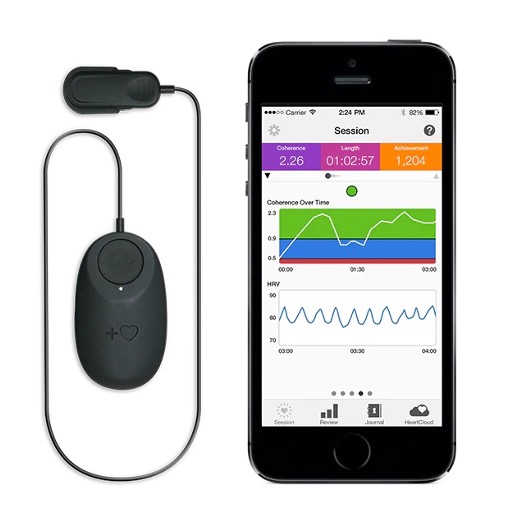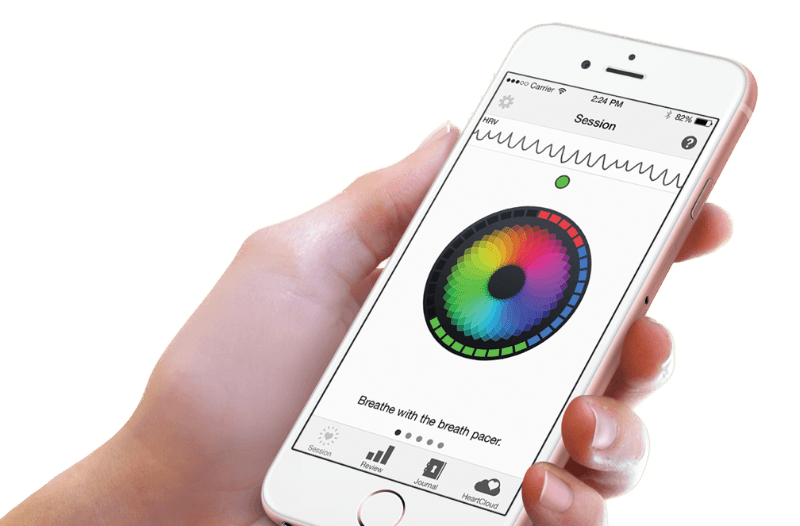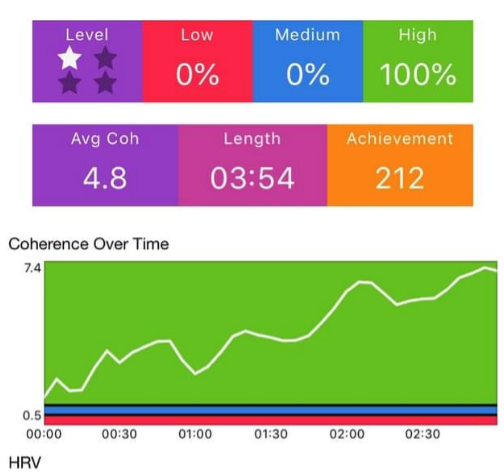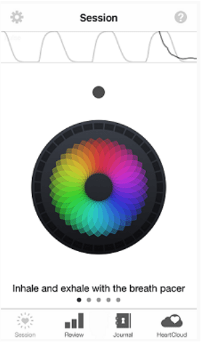What is biofeedback?
Biofeedback is a tool used to practice self-regulation and can help improve anxiety, stress, sleep, mood, and more. There are several kinds of biofeedback, and at Walden, we use heart rate variability (HRV) biofeedback that helps you learn from your own nervous system. It’s an exciting new tool to help learn self-regulation skills and develop trust that these skills truly do make a difference.
How does biofeedback work?
 During a biofeedback therapy session, participants are hooked up to a simple electrical sensor that displays visual information on a screen where they can “read” what’s going on in their nervous system. They can see the difference between fight-or-flight (sympathetic mode, which shows up as red) and a calm state (parasympathetic mode, which shows up as green).
During a biofeedback therapy session, participants are hooked up to a simple electrical sensor that displays visual information on a screen where they can “read” what’s going on in their nervous system. They can see the difference between fight-or-flight (sympathetic mode, which shows up as red) and a calm state (parasympathetic mode, which shows up as green).
Over several sessions, participants are invited to follow a curriculum of relaxation, grounding, and self-regulation practices that allow them to witness the change that can take place on the screen, and in their nervous systems. They’re asked to explore: what helps them “get into green” (calm mode), and how can they maintain it? Trained facilitators help answer questions and guide discussions on how to use self-regulation in day-to-day life.
Benefits of biofeedback as part of eating disorder treatment
Using biofeedback in eating disorder treatment is about more than changing the colors on a screen. Research shows that incorporating biofeedback as part of an eating disorder treatment plan has a big impact on how people feel over time, even when not hooked up to a sensor. A report from 2021 pooled together data from 14 studies on HRV biofeedback and showed that on average, it improved depression scores. In similar studies, HRV biofeedback training has been shown to improve physical tension, anxiety, insomnia, and some PTSD symptoms after 4-8 weeks of training.
Study participants also reported an increased “ability to take in information,” or a reduction in a feeling of “brain fog,” which may mean they can get more out of the cognitive therapies they might be using, like CBT, DBT, ACT, and others.
Is Biofeedback Safe?
Over time, biofeedback therapy helps to create signals of safety in the body without overly focusing on the body, which is a way to make connection and mindfulness more accessible to those who may have felt it was previously too uncomfortable. Importantly, biofeedback also has an excellent safety profile. In fact, a study of patients who received biofeedback while on an inpatient eating disorder unit showed no adverse reactions.

What patients are saying about biofeedback for eating disorders
 After more than a year of biofeedback training at Walden’s Center for Recovery we have had the opportunity to train hundreds of patients. Many have reached out to let us know that using biofeedback for the anxiety, depression and stress that can accompany eating disorders like anorexia, bulimia, and binge eating disorder had a positive impact on their treatment episode, and some have even said they are purchasing their own personal device for home practice!
After more than a year of biofeedback training at Walden’s Center for Recovery we have had the opportunity to train hundreds of patients. Many have reached out to let us know that using biofeedback for the anxiety, depression and stress that can accompany eating disorders like anorexia, bulimia, and binge eating disorder had a positive impact on their treatment episode, and some have even said they are purchasing their own personal device for home practice!
“The [biofeedback] was instrumental in calming me down while I was having an anxiety attack. I was able to focus on my coherence levels (graph on-screen) to help guide me with my breathing. I’m looking forward to purchasing my own HRV device when I get home and continue to work on this. I know this tool is going to be essential when I have anxiety and how I will be able to control it.”
-Former Residential Client, 2021
Biofeedback is an especially powerful tool for those clients who have previously had a hard time trusting their own ability to manage their feelings when they’re in fight-or-flight, because now they can see the change on the screen when they engage in grounding skills. It’s a captivating and interactive tool for building confidence in one’s own capacity. It’s also just plain cool.
Biofeedback for eating disorders: putting it all together
 In short, biofeedback helps eating disorder treatment because it builds skills by helping a person:
In short, biofeedback helps eating disorder treatment because it builds skills by helping a person:
- See a visual representation of their physiology (building a connection with their body)
- Notice how that aligns with how they feel (building mindfulness)
- See how they can change their state when they use coping skills (building trust and self-regulation)
Over time, the more they practice, the more they can help reduce their levels of depression, anxiety, sleep issues, and more. Researchers are confident in the data, saying biofeedback “offers a promising approach” for treating a variety of symptoms (Goessl et al., 2017).
At Walden, we offer HRV biofeedback training as an integrated part of inpatient and residential levels of care at the Center for Recovery in Dedham for both adults and adolescents.
—
We know finding eating disorder care can be tough. Walden is here for you. If you are concerned that you, or a loved one, may have an eating disorder, please reach out by completing the form on this page or email us at intake_coordinators@waldenbehavioralcare.com.
—
 Lachlan Crawford, ND (she/her/hers) is the Director of Integrative Therapies at Walden Behavioral Care. Dr. Crawford, ND, received her Doctorate of Naturopathic Medicine (ND) from the Canadian College of Naturopathic Medicine, and a certificate in Contemplative Psychotherapy from the Nalanda Institute of Contemplative Studies. She completed an advanced training fellowship in Integrative Psychiatry with Dr. James Greenblatt, as part of Psychiatry Redefined. As an integrative practitioner, she is passionate about mind-body medicine, and is certified in heart rate variability biofeedback as well as mindfulness meditation. She sits on the board of the Psychiatric Association of Naturopathic Physicians (PsychANP) and is co-founder of Water and Wood, an experiential integrative medicine company offering custom retreats and workshops for groups.
Lachlan Crawford, ND (she/her/hers) is the Director of Integrative Therapies at Walden Behavioral Care. Dr. Crawford, ND, received her Doctorate of Naturopathic Medicine (ND) from the Canadian College of Naturopathic Medicine, and a certificate in Contemplative Psychotherapy from the Nalanda Institute of Contemplative Studies. She completed an advanced training fellowship in Integrative Psychiatry with Dr. James Greenblatt, as part of Psychiatry Redefined. As an integrative practitioner, she is passionate about mind-body medicine, and is certified in heart rate variability biofeedback as well as mindfulness meditation. She sits on the board of the Psychiatric Association of Naturopathic Physicians (PsychANP) and is co-founder of Water and Wood, an experiential integrative medicine company offering custom retreats and workshops for groups.
*This blog post does not necessarily represent the views of Walden Behavioral Care and its management. The Walden Blog is meant to represent a broad variety of opinions relating to eating disorders and their treatment.
References
Caldwell, Y. T., & Steffen, P. R. (2018). Adding HRV biofeedback to psychotherapy increases heart rate variability and improves the treatment of major depressive disorder. International Journal of Psychophysiology, 131, 96-101.
Criswell, S. R., Sherman, R., & Krippner, S. (2018). Cognitive behavioral therapy with heart rate variability biofeedback for adults with persistent noncombat-related posttraumatic stress disorder. The Permanente Journal, 22.
Ginsberg, J. P., & Fogo, W. (2014). Perspectives on Research on the Use of Heart Rate Variability Biofeedback for Combat-Related Posttraumatic Stress Disorder. Biofeedback, 42(4).
Goessl, V. C., Curtiss, J. E., & Hofmann, S. G. (2017). The effect of heart rate variability biofeedback training on stress and anxiety: a meta-analysis. Psychological medicine, 47(15), 2578-2586..
Imperatori, C., Mancini, M., Della Marca, G., Valenti, E. M., & Farina, B. (2018). Feedback-based treatments for eating disorders and related symptoms: a systematic review of the literature. Nutrients, 10(11), 1806.
Lee, J., Kim, J. K., & Wachholtz, A. (2015). The benefit of heart rate variability biofeedback and relaxation training in reducing trait anxiety. Han’guk Simni Hakhoe chi. Kon’gang= The Korean journal of health psychology, 20(2), 391
Lehrer, P. M., & Gevirtz, R. (2014). Heart rate variability biofeedback: how and why does it work?. Frontiers in psychology, 756.
Lin, I. M., Fan, S. Y., Yen, C. F., Yeh, Y. C., Tang, T. C., Huang, M. F., … & Tsai, Y. C. (2019). Heart rate variability biofeedback increased autonomic activation and improved symptoms of depression and insomnia among patients with major depression disorder. Clinical Psychopharmacology and Neuroscience, 17(2), 222.
Pizzoli, S. F., Marzorati, C., Gatti, D., Monzani, D., Mazzocco, K., & Pravettoni, G. (2021). A meta-analysis on heart rate variability biofeedback and depressive symptoms. Scientific reports, 11(1), 1-10
Rosaura Polak, A., Witteveen, A. B., Denys, D., & Olff, M. (2015). Breathing biofeedback as an adjunct to exposure in cognitive behavioral therapy hastens the reduction of PTSD symptoms: A pilot study. Applied psychophysiology and biofeedback, 40(1), 25-31.
Scolnick, B., Mostofsky, D. I., & Keane, R. J. (2014). Pilot study employing heart rate variability biofeedback training to decrease anxiety in patients with eating disorders. Journal of eating disorders, 2(1), 1-3.
Tatschl, J. M., Hochfellner, S. M., & Schwerdtfeger, A. R. (2020). Implementing mobile HRV biofeedback as adjunctive therapy during inpatient psychiatric rehabilitation facilitates recovery of depressive symptoms and enhances autonomic functioning short-term: A 1-year pre–post-intervention follow-up pilot study. Frontiers in Neuroscience, 14, 738






